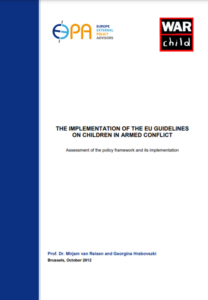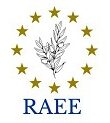Authors: Prof. Dr. Mirjam van Reisen and Georgina Hrabovszki
Publisher: EEPA and War Child
Year: 2012

Summary
2012 marked an important year for the Children and Armed Conflict (CAAC) agenda. This year, we celebrate the 15th anniversary of the appointment of the United Nations Secretary General’s Special Representative on Children and Armed Conflict (SRSG-CAAC). The newest SRSG-CAAC – Leila Zerrougui – was appointed in July, with the EU pledging its full support. This year also marks the tenth anniversary of the Optional Protocol on Children and Armed Conflict coming into force, and half a decade since the Paris Principles and Guidelines on Children Associated with Armed Forces or Armed Groups was produced.
The EU has had a strong stated commitment to the plight of children in situations of armed conflict and fragile states. In 2003, the EU created the Guidelines for Children and Armed Conflict (hereafter EU Guidelines), which were revised in 2008 and complemented by an implementation strategy. The EU also recognizes that children’s rights are a cross-cutting issue, which needs to be mainstreamed through all external EU actions.
Embracing the heightened attention to the CAAC issue, this report, commissioned by War Child Holland and War Child UK, provides an overview and assessment of the European Union’s actions on the CAAC issue, while also giving suggestions on how such action could be improved.
Part of the investigation was carried out by desk-research and interviews with relevant policymakers in Brussels, while the other part comprised of an online survey which sought the views of people in the field, namely the in-country EU-delegations and civil society representatives of War Child Holland and War Child UK.
The key argument presented in the report is that although the EU has a reasonably developed framework for CAAC, making use of this framework and implementing the commitment remains a challenge. The key problem lies in a lack of consistency in funding, training and even providing adequate attention to advancing the issue (as dictated by the rotating presidency’s priorities). Consequently, EU frameworks on CAAC have low visibility among actors in the field, further reducing its potential to make an impact on the lives of children in conflict-affected areas.
